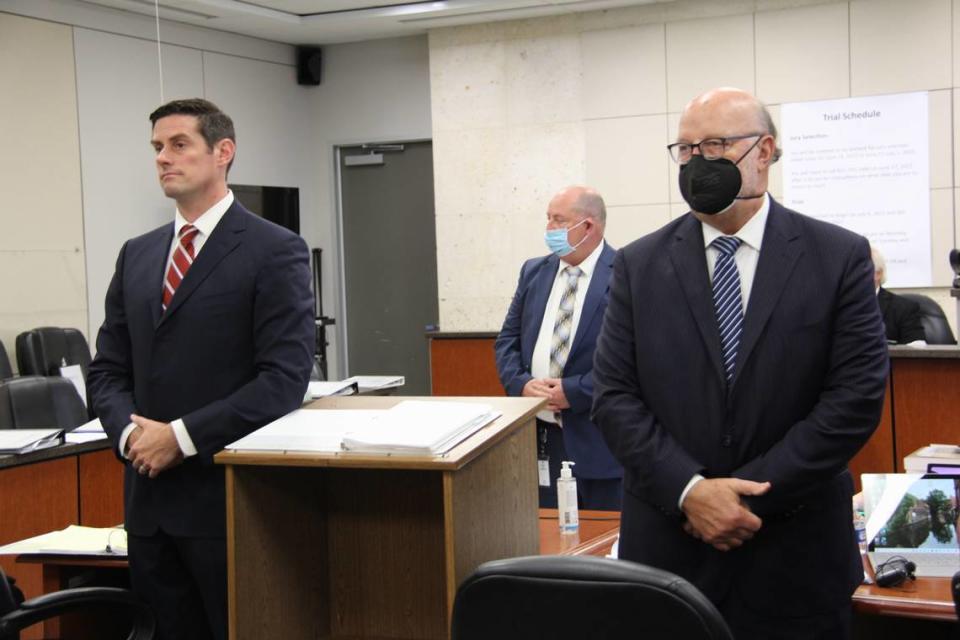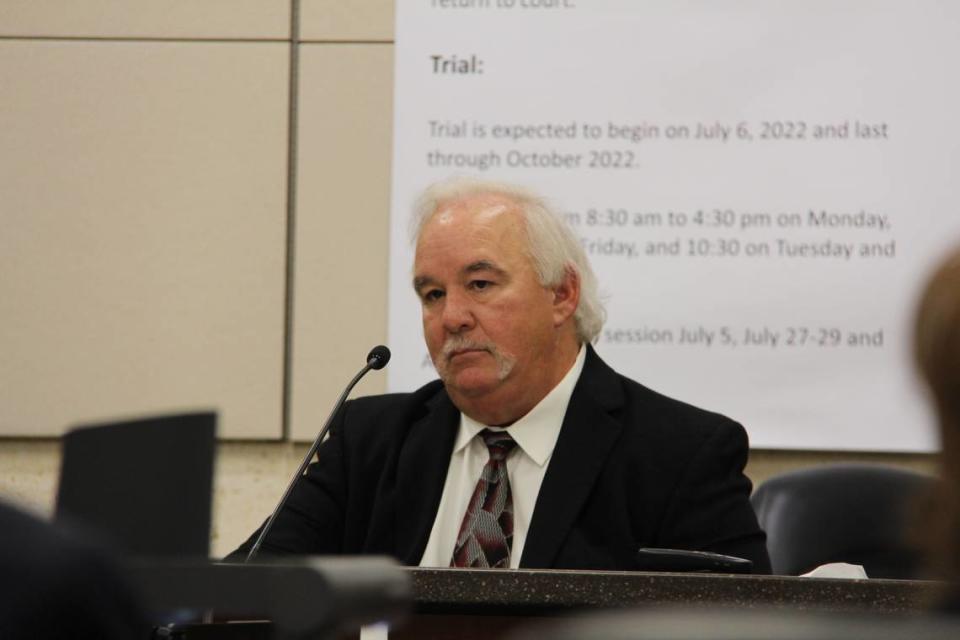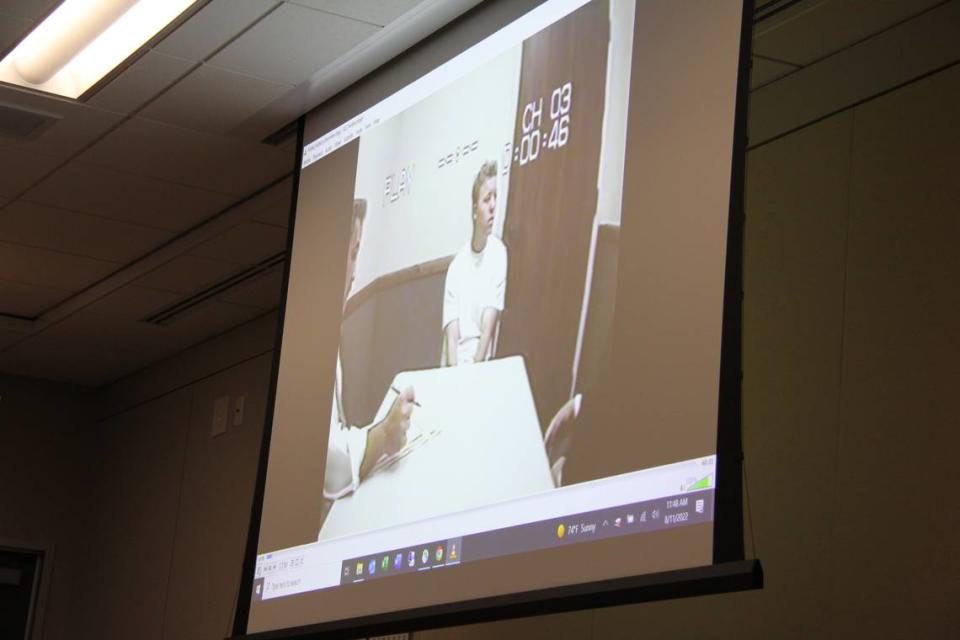Kristin Smart murder trial: Prosecution shows video of 1996 interview with Paul Flores
The trial for the men accused in the 1996 murder of Kristin Smart continued Thursday morning, with the prosecution showing a video of a law enforcement interview with Paul Flores about six weeks after Smart disappeared.
Two juries will decide the fate of Paul Flores, who is charged with Smart’s murder, and his father, Ruben Flores, who is charged with helping hide Smart’s body. Only the jury for Paul Flores was present in the courtroom on Thursday.
Smart has not been seen since May 24, 1996, after leaving an off-campus Cal Poly party. Her body has never been found.
The trial moved to Salinas after San Luis Obispo Superior Court Judge Craig van Rooyen ruled the two men were unlikely to receive a fair trial in San Luis Obispo.
Monterey County Superior Court Judge Jennifer O’Keefe had previous ruled that only Paul Flores’ jury will be present when a portion of a June 19, 1996, law enforcement interview with Flores is shown. Allegedly, Paul Flores made a statement that may implicate his father, the judge said.
The hearing began at 10:30 a.m.

Paul Flores had ‘inconsistencies’ in his story, investigator testifies
San Luis Obispo County Deputy District Attorney Christopher Peuvrelle called former San Luis Obispo County District Attorney chief investigator William Hanley to the stand.
Hanley was a senior investigator for the District Attorney’s Office at the time of Smart’s disappearance. He was tasked with investigating the case after the Cal Poly Police Department asked the District Attorney’s Office for assistance, he testified Thursday.
Flores was interviewed by Hanley two times in 1996: first on May 31, and again on June 19.
In the May 1996 interview, Flores told Hanley and his partner that Smart introducing herself as “Roxy” at the party where she was last seen and it was his only interaction with her until he walked her home, Hanley said.
Flores denied being attracted to her, telling investigators he’s not attracted to “girls like that,” because supposedly Smart was flirting with several boys at the party, Hanley testified.
Hanley said Flores told investigators he saw a girl from his statistics class, later identified as Cheryl Anderson, and Smart standing outside the party when he decided to leave around 2:30 a.m. Flores decided to walk with them because he knew they were going to the dorms, but did not elaborate on how he knew the two girls were walking there, Hanley said.
Flores told Hanley he rubbed Smart’s shoulders one or two times during the walk because she was cold, but said “it was not sexual in nature,” Hanley said.
Flores told Hanley and his partner that he told Anderson, “Goodbye,” and went with Smart in the other direction before going to his dorm, Hanley said.
When asked why he didn’t walk Smart, who was clearly intoxicated, all the way back to her dorm, Hanley said Flores replied, “I didn’t even think about it.”

When asked during his interviews if he thought Smart was alive or dead, Flores said he believed she was dead, Hanley testified.
Flores could not account for what he did between Saturday morning and Saturday evening when he got dinner or what he did after dinner through Sunday morning, according to Hanley.
When asked about a black eye Flores had, Hanley testified Flores said he was elbowed during a basketball game on Sunday.
Hanley and his partner decided to interview Flores a second time to “confront him about inconsistencies” with his story, Hanley said. The second interview was filmed at the Arroyo Grande Police Department on June 19, 1996.
Hanley said in the second interview, Flores told two different stories of how he got his black eye: He said he wasn’t sure and that he received it while installing a stereo in his truck, Hanley said.
Flores did not mention being pushed at a party in either interview, which is what another witness testified Flores told them earlier in the trial.
In the second interview, Flores told investigators that Smart leaned into him for support and reiterated he was not attracted to her.
Hanley said Flores denied allegations that he had asked Anderson for a hug and kiss before parting ways, and continued to deny having contact with Smart at the party beyond her introducing herself.

Video of 1996 interview with investigators played
During Thursday’s proceedings, Peuvrelle played the video of the June 1996 interview for the jury.
In the video, a young Flores is wearing a white T-shirt and has his arms folded as he sits at the head of a small table. Investigators are seated on either side.
In the first 13 minutes of the video, Hanley and his partner asked Flores what he thought happened to Smart, to which Flores replied he didn’t know, but said she had maybe gotten into a car or walked to Taco Bell with someone.
Investigators pressed Flores in the video, asking him to assume something bad happened to Smart, and asked what he thought happened in that context.
“I’d guess someone she hitchhiked with abducted her or something,” Flores replied.
Investigators continued to ask Flores what he thought happened for a few minutes, and Flores repeated he wasn’t sure.
“Do you think it was an accident?” investigators asked in the video
“I guess anything’s possible,” Flores replied.
Investigators asked if Flores ever tried to kiss Smart at any point in the party or on the walk home and Flores said, “No.”
Investigators told Flores four to five people witnessed him try to kiss Smart at the party, and said he fell down with her. Flores said he did not remember that happening, and said maybe people thought he was someone else.
Investigators told him the witnesses identified Flores as the person who was trying to kiss Smart when shown a photo.
In the video, Flores said he kissed another girl at the party but didn’t know her name. He told investigators he did not remember talking with Anderson or Smart on the walk home, and if they did, it wasn’t significant enough to stick with him.
In the rest of the video, investigators pressed Flores on things he said he didn’t remember, like asking a girl who told him she a had a boyfriend for her cell phone number. Flore held that he did not remember falling with Smart or trying to kiss her.
Investigators told him two girls said Flores tried to forcibly kiss them, which Flores said he didn’t remember. He says he may have “blacked out” at various moments of the night.
“That’s not how blackouts work,” investigators responded. “You don’t blackout one moment and remember the next.”
Flores told investigators that on an intoxication scale of one to 10, he was at a seven or eight the night Smart disappeared.
When pressed about his black eye, he told investigators in the video he got it by hitting his eye on his steering wheel while working on his car stereo in the early hours of Monday morning. Investigators ask why he lied to them during the May interview and lied to a friend about it, and Flores said he thought if he said the truth he would look like a klutz.
He also said he didn’t think how he got the black eye mattered.
“What if Roxy punched you in the eye? See why that’s important?” investigators asked.
Investigators said during the interview that someone had seen Flores with a black eye on Saturday, but Flores insisted he got the black eye Monday.
Investigators then tried to convince Flores to take a polygraph test, to which Flores said he had to ask his parents first.
“They told me not to talk to you guys,” he told investigators.
The tape ended with the same portion that was shown in opening statements, where Flores said he wasn’t telling lies, but rather “fibs” or “white lies.”
Investigators lied to elicit confession, defense says
On his cross-examination, Sanger asked Hanley about investigative techniques law enforcement officers use to elicit confessions, particularly using polygraphs and lying during interrogations.
Hanley confirmed that much of what was said by investigators in the June interview was false in whole or in part. He said giving false information to subjects is allowed as long as it does not elicit a false confession.
Hanley testified that they had actually not spoken to someone who had seen Flores with a black eye Saturday evening, but rather someone who said he had it Sunday or Monday evening.
He also said there was one person — not four to five — that at the time of the June interview had said they saw Flores and Smart fall to the floor together at the party.
“Was (Hanley’s partner) overstating to elicit a confession?” Sanger asked.
“I do not know the reasons for him saying five,” Hanley responded.
No one picked Flores out of a photo line-up, and no one saw Flores and Smart together somewhere different than where Flores had already told investigators, Hanley confirmed during his testimony Thursday.
There was also no one else who had lied to police at first for fear that innocent behavior would make them look suspicious, Hanley said. Hanley had told Flores this during the June interview in an effort to get Flores to tell him more information.
“I can’t talk about what I can’t remember,” Flores said in the interview.
Sanger also accused Hanley’s partner of “threatening” Flores with a polygraph test as an investigative technique to draw out a confession, alleging it was a technique the partner would feature in presentations he put on about how to get confessions.
Hanley said he never heard his partner use the phrase “threatening with a polygraph test” and that asking someone to take a test is not a technique. Rather, he said, a polygraph test is an investigative technique itself.
The focus of Hanley and his partner’s interviews and investigation was Flores specifically, Hanley confirmed to Sanger. Hanley said that is who Cal Poly Police Department told them to investigate on May 31 1996. Prior to that date, he was not aware of who Flores was or his connection to the case, he said.
The May interview was not recorded, and Hanley’s testimony was “almost verbatim” from his written report that summarized the conversation, Sanger said. Hanley said he did review his 1996 reports before testifying.
Sanger pointed out that even with investigators lying to Flores, Flores did not change his story during the June interview.
Hanley was excused and court was adjourned for the day. Witness testimony is expected to resume Friday. Juries for both Flores men will be in attendance.

